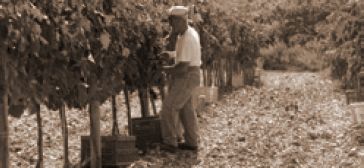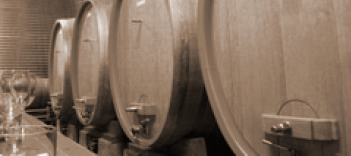"The yearly production of traditional Brunello di Montalcino DOCG respectively Rosso di Montalcino DOC amounts to about 4500 liters as well as 700 to 1000 liters of Cabernet Sauvignon."
... Numbers, Facts, Data...
In the meantime, the vine cultivation area consists of 1.7 hectare of which there are 1 hectare Brunello di Montalcino DOCG, 0.4 hectare St. Antimo DOC Sangiovese and 0.3 hectare St. Antimo DOC Cabernet Sauvignon. An expansion of the vine cultivation area is not planned and for the most part the agricultural ground consists of olive groves and mixed areas.
The vineyards are located at an altitude of about 250 to 300 meters above sea level and are optimally situated to the southwest. The stony "Galestro ground" guarantees very good drainage and stores solar energy also very well. In the wine one can taste the warm climate the grapes are growing in. The special micro-climate of this region exists because the Orcia Valley opens to the west which allows a steady air circulation from the sea, even in the hottest summertime. The yearly precipitation in our area is much lower than in the other wine growing areas of Montalcino, this guarantees exceptionally full-bodied and intensive wines.
In 2000 we built with the most modern technology a completely below ground up-to-date wine cellar, which allows the wine to be stored and age at a constant temperature. Robert Baumann personally and enologist Jan Erbach (who is living in Montalcino and working for La Pieve since 2002) are guaranteeing the quality based on the standards they set.
The barrels for Brunello di Montalcino DOCG and Rosso di Montalcino are traditionally new and were manufactured for the first time for Montalcino by Fassbinderei Mittelberger in Bolzano (Bozen) in French or Austrian oak. The barrel sizes are 2000 liters as well as Tonneaus of 500 liters made of French oak. The production of Cabernet Sauvignon barrels is carried out separately in new barriques of 225 liters also made of French oak.
The yearly production of traditional Brunello di Montalcino DOCG and Rosso di Montalcino DOC amounts to about 4500 liters as well as 700 to 1000 liters of Cabernet Sauvignon. Adding Sangiovese to the Cabernet Sauvignon creates an assemblage named St. Antimo rosso DOC, which is called "Agave" due to the over abundance of agaves growing in this area. The proportion between Cabernet Sauvignon and Sangiovese is determined each vintage year, so that an optimum balance of the characteristics of the two grape varieties is achieved. This results in a well-balanced end product (for example: 70% Cabernet Sauvignon, 30% Sangiovese).


